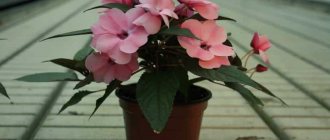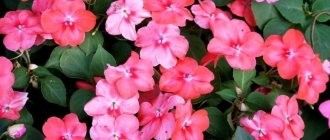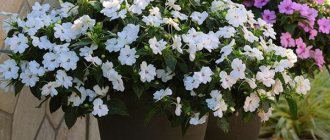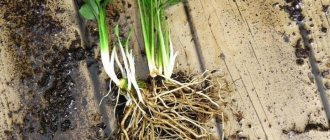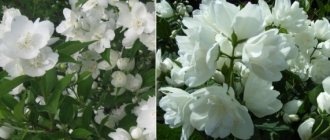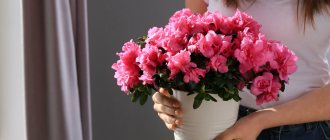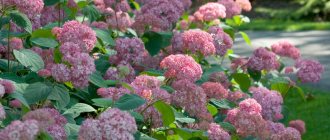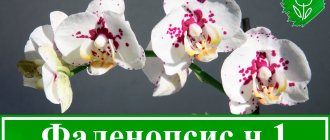Botanical description
The indoor flower Ivan wet grows up to half a meter in height. Its stems are erect, branched, and smooth. The leaves are oval or lanceolate, with small teeth along the edges. Foliage color is purple-bronze or green.
The buds are formed in the axils of the leaves. In cultivation there are varieties with a variety of colors, with the exception of the blue tint. Flowers simple or double. After pollination, green fruits are set; as they ripen, they turn into a dry seed capsule.
Why is the flower called this and what is the correct scientific name? The home flower Vanka wet has other names. All of them are due to the properties of the plant. If you touch a ripe seed pod, it will immediately open the valves and shoot out seeds. For this reason, balsam impatiens was nicknamed “touchy.” Another name – “light” – is associated with bright and abundant flowering.
In reviews, experienced flower growers write that balsam does not tolerate cramped spaces on the windowsill. It grows much better separately, without proximity to other plants.
Signs and superstitions associated with Balsam
There are several good and one bad signs associated with Balsam.
Let's start with the bad. It is believed that the presence of Balsam in the house leads to alcohol addiction of one of the family members. This is because the plant loves abundant and regular watering. This is how the analogy appeared. Addiction to water = addiction to drinking.
They also say that the wilting of a flower is associated with an unhealthy atmosphere in the house. This means there is discord in the family, scandals and mutual distrust.
Positive signs:
- Balsam brings good luck to men and people of creative professions.
- A pot with a flower is given to newlyweds so that they quickly get used to family life and living together.
- The plant “cleanses” the energy of the room, absorbing negativity and negative emotions.
Popular types and varieties
According to various sources, the number of balsam genus ranges from 400 to 550 species. The most common traditional varieties are spreading bushes with red and white flowers.
Gradually, they began to be replaced by new hybrid varieties - they are distinguished by more compact, dense bushes, abundant flowering, and new colors. Variegated (variegated) forms of the plant belong mainly to New Guinea hybrids. The most common are four varieties.
- Waller's balsam. The form includes several different hybrid varieties with similar characteristics. The height of the bush is up to half a meter or slightly higher. The stems are bare, highly branched, thick. Thin leaves are held on long petioles. The flowers are separate, large, located at the ends of the shoots. The coloring is different. There are terry forms.
- Peters' balsam. Quite a tall, bushy plant. Stems slightly pubescent. The color of the ground part has a bronze tint. Flowers are fiery in color, on long stalks.
- Niamey balsam. Bush up to a meter tall, with long, branched stems. The leaves are oblong, densely located on the stem. Buds on long stalks are formed in the leaf axils. The flowers are predominantly red. There are two-color varieties with an admixture of yellow splashes.
- New Guinea balsam. Includes a group of tall and compact perennials. The flowers are of different shades, the leaves are quite large.
Wet vanilla (balsam) will bloom more profusely if you regularly pinch the shoots. Due to this, branching increases and more buds are laid. Dwarf varieties of balsam do not need to be pinched.
Appearance
This variety of balsam is a shrub, with a height of 45 cm to 70 cm. The leaves are dark green, the trunk and branches are light green. The leaves are heart-shaped, up to 4 cm wide, up to 10 cm long. The flowers are medium in size.
“Vanka wet” is a very fragile flower; stems and leaves can break even from the wind. The peculiarities of this plant lie in the droplets of juice that are secreted by the leaves and the translucent structure of the trunk and branches. If you direct the sun's rays onto a flower, you can see the internal structure of the stem.
Caring for Vanka wet: what to consider and how to propagate
Impatiens is a relatively easy plant to care for. In an apartment you can create favorable conditions for it, achieving long-term, almost year-round flowering. To do this, you need to follow the recommendations of experienced flower growers.
- Lighting. All balsams love diffused but bright light. Direct sunlight is undesirable - on southern windows the plant is protected with tulle. The optimal location is east or west. Impatiens respond well to frequent airing of the room or moving to the balcony in warm weather. In summer, planting in the ground is allowed with the onset of stable heat. Impatiens do not have a pronounced dormant period, so additional lighting is required in winter.
- Temperature. Impatiens love warmth and can easily withstand heat up to 30˚C. The optimal temperature is considered to be from 20 to 25˚С. In winter, it needs relative coolness of at least 15˚C.
- Watering. In spring and summer, it is recommended to water immediately after the soil surface dries. In autumn and winter, moderate watering is maintained - after the surface layer of soil dries, wait two days. They try to maintain stable soil moisture and use warm, settled water.
- Humidity. At temperatures below 22˚C, balsam adapts to dry air. In hot weather, frequent spraying is needed.
- Feeding. Balanced fertilizers are applied twice a month for beautifully flowering crops. The bulk of fertilizing occurs during the active growing season. If flowering continues in winter, occasionally the balsam can be fed with a half dose of complex fertilizer.
- Trimming. To preserve decorativeness and stimulate flowering, balsam is “cut” in the spring, cutting the stems by a third or half the length. As the side shoots grow, the tops are pinched. Weak, unnecessary branches are pruned at any time of the year.
- The soil. The optimal soil for balsam is a mixture of deciduous soil, humus, turf and sand. All components are taken in equal quantities.
- Transfer. The most favorable time for transplantation is the beginning of spring. Young specimens are replanted every year. If necessary, you can replant in the summer. Many gardeners recommend using the transshipment method.
Wet Vanka does not bloom in bulk containers. To stimulate flowering, the main shoots are shortened and transplanted into a smaller container. When caring for balsam, maintain stable soil moisture - drying out can lead to the death of flower buds and the fall of buds at the stage of their formation.
Possible problems
Despite the unpretentiousness of balsam, mistakes made in care can lead not only to loss of decorativeness, but also to its death.
The most common problems:
- Leaves curl . This sign appears when the plant suffers from a draft. Therefore, it is necessary to move it to a more secluded place.
- Pulling out shoots . The problem occurs when there is insufficient lighting, as well as when the balsam is kept hot. In this case, it is necessary to adjust the care.
- The buds dry out and fall off . This occurs when the air is dry and the root system dries out. To solve the problem, you need to regularly water the balsam, and also spray it periodically.
- Leaves and shoots have lost turgor . This occurs when moisture stagnates for a long time in the pot, which causes rotting of the root system. In this case, the plant must be removed from the container, the affected areas of the roots must be removed, planted in a new substrate and watered with Previkur Energy solution.
Reproduction methods
Flower growers practice seed and vegetative propagation. Both methods are effective, but sowing seeds from a hybrid plant can give unexpected results - the main characteristics of the variety change. To obtain seedlings of a certain variety, store-bought seeds are often used.
Seeds
The favorable period for seed propagation is spring. But if you sow the seeds in February, you can get a beautiful flowering bush in May. A mixture of sand and peat is used as a substrate. To obtain strong seedlings, a certain sequence of actions is followed.
- Seed preparation. Planting material is soaked for ten minutes in a weak solution of potassium permanganate, washed and filled with warm water for an hour. The seeds are slightly dried.
- Landing. The container is filled with pre-prepared substrate. Seeds are distributed over its surface and sprinkled with a thin layer of fine sand on top. The container is covered with film.
- Conditions for germination. Maintain a stable temperature in the range of 18–20 ˚С. Once every two days, open the greenhouse, remove excess condensation, and moisten the soil with a spray bottle as necessary. If possible, install additional lighting.
- Picking. After two true leaves appear, the seedlings can be planted in separate small pots.
- Topping. At the stage of five to nine leaves, the young plant is pinched to stimulate branching.
Cuttings
Reproduction of Vanka wet by cuttings allows you to quickly grow a young plant to replace the old one. Cuttings are specially cut or the apical shoots remaining after spring pruning are used. Rooting is carried out in the following sequence.
- Preparation of cuttings. The optimal cutting length is 5–6 cm. The upper leaves are cut in half, the lower leaves are cut off completely.
- Root growth. The cuttings are placed in water with the addition of activated carbon tablets and root formers.
- Landing in the ground. After the roots have formed, the cuttings are placed in light soil. They are kept under film for a week to smooth out temperature changes and maintain stable humidity.
- Topping. The growing point of a young plant is pinched to stimulate branching.
The bush can be made more lush if several cuttings or seedlings are planted in one pot at once. A distance of about 5 cm must be maintained between plants. Flower growers recommend planting seedlings of the same variety in a common pot.
Reviews
Bulygina Valentina Petrovna, 35 years old, Kazan: “I can’t imagine my garden without balsams. Wonderful unpretentious flowers. I plant hanging varieties in hanging flowerpots and decorate the terrace with them. I plant terry species in high beds along with fuchsia, alternating with hostas. The Toy Thumb variety is my favorite. I buy only hybrid seeds, I collect the rest myself, it’s very simple, the seed material is large, reminiscent of peas. I recommend using Vanka wet in flowerpots and group plantings.”
- Author: Maria Sukhorukikh
Rate this article:
- 5
- 4
- 3
- 2
- 1
(0 votes, average: 0 out of 5)
Share with your friends!
Possible growing difficulties
Unsuitable soil, microclimate, and errors in maintenance conditions immediately affect the appearance of balsam. You can familiarize yourself with care errors and their consequences in the table.
Table - Possible difficulties when growing balsam
| External manifestation | Main reasons | Help the plant |
| Vanka's wet leaves are turning yellow | – Dry air; – waterlogging of the soil; – root rotting; – excess fertilizer | – Check the root system for rot; – adjust the care regimen |
| The leaves are drooping | - Heat; – lack of moisture | – In hot weather, balsam is sprayed; – water regularly, avoiding stagnation of moisture |
| Vanya's wet buds are falling off | – Dry air; – excess fertilizer; - cold; – soil drying out; – pest invasion | – During flowering, balsam is kept in moderate heat; – water regularly; – dilute the fertilizer according to the instructions |
| Variegated forms lose their characteristic color | – Lack of light; – excess fertilizer | – Move the balsam to a bright place or install additional lighting |
| Leaves fall, flowering stops | – Lack of light combined with low temperature; | – Until the end of flowering, maintain a stable temperature of at least 20˚С |
| Leaves become smaller, stems become longer | – Cramped pot; – lack of nutrients; – poor lighting; – heat | – The balsam is cut off and transplanted into a larger pot; – adjust the conditions of detention |
| Leaves curl and fall | – Cool content combined with waterlogging of the soil | – Reduce watering; – increase the temperature of the contents |
If the balsam suddenly turns yellow, wilts and begins to shed its leaves, this is a sure sign of stress. Its condition is negatively affected by drafts, sudden temperature changes, and changes in lighting intensity.
LiveInternetLiveInternet
Quote from Bausova_Natalia's message
Read in full In your quotation book or community!
Indoor balsam or Vanka Wet. Cultivation, healing properties and signs.
Roly-wet, balsam, flame, evergreen, impatiens
- no matter how people called the houseplant, which is known to science as Impatiens.
Before becoming the favorite of most housewives, the flower traveled a considerable distance. After all, its historical habitat is the tropical and subtropical countries of Asia, America, and Africa. Balsam first appeared in Great Britain. At the end of the 16th century, it was presented as a gift to Queen Elizabeth I. The ruler was amazed by the unusual flower, on the stems of which there were frozen sugar tears. This plant was brought to Russia at the beginning of the nineteenth century. The Russians loved him for his unpretentiousness. And for its ability to bloom practically all year round and decorate the house, the plant began to be called an eternal flame or an everlasting flower
.
In Russia, balsam is known and loved so much that it has even appeared in classical Russian literature - remember Balzaminov from the play by A.N. Ostrovsky “What you go for is what you will find” or the lines of Dostoevsky’s novel “Poor People”: “I see that the corner of the curtain at your window is bent and attached to a pot of balsam...”. "Vanka wet"
This flower is popularly called - in inclement weather, with the approach of a thunderstorm, during fog, and also with abundant watering, droplets of water stand out on the sharp tips and serrated edges of its light green leaves - the plant becomes really wet.
They are also called “light”
- in the dark foliage its little flowers-lights “burn”: white, pink of all shades, salmon, orange, yellow, red, purple - one-color, as well as with an “eye” or stripes - “burn” in any weather, 6-8 months a year (what other plant will bloom for as long?).
There is another “Russian folk” name for the flower - impatiens
. After pollination of balsam flowers, fleshy green fruits are formed. But the juicy “berry” suddenly dries out, turning into a box. As soon as you touch it lightly, it bursts, shoots out rather large seeds and curls its flaps inward - here you have a “touch-me-not.” In England they also love this plant - and they lovingly call it “zealous Lisa”, for its eternal flowering, look for another hard worker like this. If you are a beginner gardener, get some balsam. You will not regret! It's no secret that most indoor plants are considered as a mysterious way of influencing the lives of the inhabitants of the apartment. Therefore, there are many beliefs that housewives pay attention to before letting this or that flower into their home. Thus, in the Russian outback they believe that the appearance of Vanka the Wet in his home will cause her husband’s alcoholism in the future. The reason for such reasoning and fears was droplets of sap on the stems of the plant. This is the only “stain” on the reputation of balsam. Most consider him a protector and benefactor of creative people. Some even manage to predict the development of their career (difficulties and ups). The secret is simple: if a flower grows and blooms, then nothing threatens its owner. And as soon as the plant begins to hurt and dry out, troubles and negative changes occur in a person’s life. The presence of a resident like Vanka-mokry in the house helps to gain self-confidence, opens up hidden reserves, and gives the necessary energy boost at a new stage of life. As evidenced by folk signs, people consider Vanka-wet to be the flower of “male happiness.” In order for male strength to never leave the stronger sex of the family, there is no need to prepare any special drugs, tinctures or potions. It is enough to simply place the plant in the bedroom or office, for example, on the window. Therefore, it was not in vain that newlyweds were given balsam as a wedding gift. People say that Vanka the Mokrogo has an overly sensitive aura. Even a careless, rude word can significantly reduce its positive impact. Therefore, spouses who have “sheltered” balsam in the house should avoid quarrels and showdowns in their home.
Care and cultivation of Balsam:
It is easy to care for. The main thing is not to forget to drink. The soil in the pot should always be moist (remember - he’s wet). With a lack of moisture, the leaves immediately wither, wither, turn yellow and soon fall off. If you do not water the plant for 2-3 days, the tops of the stems will begin to dry out and the balsam may die. In summer, daily watering may be necessary. In winter, watering is reduced. Content temperature:
Moderate, in winter not lower than 12˚С.
For the plant to bloom in winter, the temperature must be at least 15˚C. He's an African - he loves warmth! Lighting:
The plant is light-loving, but in summer it should be protected from direct sunlight by moving the plant into the shade.
Flowering in winter requires several hours of direct sunlight per day. Air humidity:
From time to time, the leaves should be sprayed, avoiding water getting on the open flowers.
Replanting:
Blooms well only if the roots fill the pot.
Soil - 1 part turf soil, 1 part leaf soil (peat), 1 part humus, 1 part sand. There must be drainage at the bottom. It is better to replant balsam annually in the spring (in March), and it is not necessary to take a larger pot, since Vanka wet does not like too spacious dishes; it is enough to completely replace the soil. Reproduction:
By stem cuttings at any time of the year or by seeds in spring. You can rejuvenate the plant quite often, i.e. cut fresh, long, stronger cuttings, and, after rooting, plant them instead of the old plant; over the summer they will have time to grow greatly. If the plant does not have enough light, it stretches out and becomes ugly. I recommend that you renew the balsam about once a year - the cuttings take root easily in water, sometimes even without stopping to bloom. You can plant several plants, both the same color and different ones, in one pot - the effect will be amazing. If you are an experienced gardener, you should not snort disdainfully in the direction of balsam: have you seen the latest innovations? What colors of flowers there are! What terryness! There are even variegated varieties!
What else is good about balsam?
In recent years, I like to plant it on the balcony and in the country. The flowering edges of our garden have long been the subject of discussion and the envy of our neighbors. When balsams are grown outdoors, they love a bright place, but protected from direct sunlight - the balsam flowers turn out brighter and larger.
Problems when growing balsam
♦ The stems are elongated, the leaves are small and pale - when there is a lack of nutrients in the soil, or when the pot has become cramped, as well as when there is insufficient lighting. In addition, most types of balsam are characterized by rapid “growth”, causing the plant to stretch, the stems at the base become bare, and the decorative appeal is lost. High temperatures (above 22 °C) contribute to this. Therefore, it is advisable to renew balsam in the spring by cutting and rooting several young cuttings in one pot. ♦ The stems rot (turn brown and soften), the leaves curl and fall off if it is too cold and damp. This can happen if the plant is placed in the garden in the summer, with the onset of cold rainy nights. ♦ Leaves curl, dry out and fly off - if the dry air is too hot. This should be feared in winter if the plant is located close to a heating radiator. And also in the summer, on hot sunny days, then the plant should be placed on the floor in the coolest place in the apartment and sprayed periodically. ♦ Variegated forms lose color - with insufficient lighting, for example, on a northern windowsill. ♦ Flowering is weak or absent - the reason may be a lack of light, a lack of nutrients in the soil or an excess of fertilizer (improper fertilizing, for example, nitrogen fertilizers). ♦ Unexpected flying of flowers and cessation of flowering - can be caused by a sharp cold snap, severe drying of the soil, transplantation into a pot that is too large, or untimely transplantation (time of flowering or bud formation).
Balsam pests:
Spider mites often infect balsam, especially in hot, dry weather - cobwebs appear in the internodes and on the stems, the leaves become sluggish, pale and fall off. Control measures.
The entire above-ground part must be rinsed in soapy water. To do this, dilute a strong soap solution in a bucket of warm water (you can use green soap, tar soap, and even dishwashing foam). Then lower the plant upside down and leave for about five minutes. Rinse off the foam with warm, clean water from the shower. Repeat the procedure in a week. If soap baths do not help, the balsam should be sprayed with an acaricide solution (preparations: Apollo, Nissan, Vermitec, Actellik and others). Also, balsam, especially growing in the garden in summer, can be harmed by aphids, whiteflies and thrips. Be sure to inspect the underside of the leaves (pests usually hide there), pay attention if the leaves curl, turn yellow or acquire a gray-silver tint. The easiest way to combat the above pests is with the help of systemic insecticides - actara or confidor, the solution of which is watered on the soil. All diseased, damaged leaves need to be cut off.
Composition and medicinal properties
Note that the composition of the plant has not been sufficiently studied. Therefore, its medicinal properties are also not fully known. Some studies indicate that this plant contains poison. However, despite this, balsam is actively collected during its flowering period, because it is at this time that it contains the highest concentration of vitamin C. For this reason, this remedy is used to treat various inflammatory processes. The balsam flower contains tannins necessary to support vital processes, flavonoids and alkaloids. Most often, herbalists use the above-ground part of the plant for medicinal purposes. Its components are part of diuretic herbal remedies. Such drugs have a beneficial effect on the functioning of the kidneys and on the entire urinary system of our body, since the substances in balsam are able to break down salts and stones and remove them along with excess fluid from the body. For this reason, impatiens are used to treat swelling of the heart and kidneys. This medicinal plant is also highly valued in Chinese folk medicine.
.
According to Eastern healers, it perfectly helps to cope with the normalization of the menstrual cycle and treats toxic poisoning. Some studies suggest that balsam may stimulate labor. However, its relation to the category of poisonous plants does not provide grounds for using it to stimulate labor. Balsam also found its special medicinal niche in Tibetan medicine
. There, it is used to treat diseases such as ascites and spasmophilia, diabetes mellitus. Tibetan medicine also actively uses the sedative properties of this natural remedy. Under the influence of the medicinal plant, the nervous system calms down, the heart rate slows down, and the amplitude of heart contractions increases.
The use of balsam in folk medicine: recipes
1. Infusion for the treatment of kidney stones.
It is used by herbalists in the Caucasus and Asia, the Urals and Siberia to gently remove kidney stones.
You need to take a teaspoon of crushed fresh leaves of the plant and pour 200 grams of boiling water over them. After infusing for half an hour, take a tablespoon each time after a meal. But first, this healing liquid should be tested for tolerance by the body. After all, sometimes it can cause vomiting. 2. Treatment of wounds and hemorrhoids with balsam leaves.
Fresh leaves of this medicinal plant are used as a remedy against hemorrhoids, ulcers, and wounds.
To do this, wash the balsam leaves by kneading them in your hands and applying them to the skin lesions. If a strong burning sensation occurs, the leaves should be removed and the skin should be washed. This is individual intolerance to balsam. 3. Infusion for the treatment of rheumatism.
External use of balsam in the form of decoctions is very effective in the treatment of rheumatism.
You need to take 100 grams of fresh balsam leaves and pour one liter of boiling water over them. After complete cooling and filtering, the balsamic infusion is poured into a warm bath. You should take such baths daily until you feel better. 4. Treatment of varicose veins.
Balsam leaves have a good effect on the health of blood vessels, namely the elasticity of their walls.
Therefore, such properties of balsam in combination with its anti-inflammatory properties make it possible to successfully treat varicose veins. To do this, prepare the leaves of the plant by washing them thoroughly. After this, it is necessary to chop the medicinal raw materials very finely. The resulting medicinal mass is loosely wrapped in gauze and then its contents are doused with boiling water. When warm, such a compress is applied to the sore areas of the legs for approximately 10-15 minutes. 5. Balsam juice as an anti-inflammatory agent.
Fresh juice from the leaves of this medicinal plant is taken in the presence of inflammatory processes in the body. It acts as an analgesic and anti-inflammatory agent. However, it is important to follow the dosage with this treatment. It is necessary to dilute 2 drops of juice with 50 grams of boiled water.
Contraindications for use
Before starting therapy with any balsam-based preparations, you should consult your doctor or an experienced herbalist. Experts will help you specify the daily doses of decoctions and infusions of this remedy. The medicinal plant has a number of contraindications:
■ Uncontrolled consumption of balsam juice and infusions can cause very severe poisoning of the body in the form of nausea, vomiting, and dizziness. ■ The use of any impatiens-based preparations by expectant mothers and women while breastfeeding is strictly prohibited. ■ The use of such products by children under 14 years of age is prohibited. ■ If you have diseases of the gastrointestinal tract, taking medications with balsam will only aggravate the situation, causing irritation of the intestinal and stomach mucous membranes. * * * * * When this plant settled in my house, I began to notice interesting changes taking place in my life. But I didn’t immediately understand that indoor balsam had such an effect, I found out a little later. I just read after a while that the light has powerful solar energy. I think that when you read the article to the end, you will want to urgently purchase this plant. The first thing I would like to note is that balsam has a beneficial effect on a person who is depressed, quietly helping him get out of a difficult condition. For people who are too passive, who cannot do anything in life, make decisions and are generally unable to change their lives, it is also important to have this plant. Thanks to the flower, you will feel a huge surge of strength and confidence that you can change everything.
Energy benefits of indoor balsam
The flower has many other beneficial properties. For example, there are other plants that help a person feel a surge of strength, for example, azalea. But azalea does it a little roughly, and the person experiences some unpleasant sensations. Balsam acts in this regard much more gently and any changes in your life under its influence occur completely painlessly. 1) It is beneficial to keep this plant in a house where there are little fidgets that cause a lot of anxiety to their parents. The flower will help your children become more independent and organized and even obedient. Balsam is a real lifesaver for children who live in unfavorable families where scandals often occur. 2) If you yourself, or someone close to you, is in a state of depression, then place this plant wherever you can and in two weeks you will see changes taking place. For example, a person in such a state will suddenly want to do something to change the situation, and not stupidly feel sorry for himself. 3) The plant is also necessary for creative individuals, as it instills inspiration in a person. Ogonyok activates a person’s hidden capabilities, tunes him to the right vibrations and helps him solve even the most complex problems. If you need to come up with something, but no ideas come to mind, then try sitting in silence next to a light for 10-15 minutes and you will be surprised to find that interesting ideas begin to come to mind. 4) Balsam is also important where there are students: schoolchildren or students - it arouses interest in learning. Just place the plant in the children's room and you will be surprised to notice that you no longer need to force your child to learn his homework, he now does them himself. If a child finds some object very difficult, then very soon this will cease to be a problem if there is a balsam flower nearby. Under the influence of the plant, hidden human capabilities begin to activate, which we rarely use. 5) Balsam also has a strong cleansing effect. Its strong vibration pushes all energy debris out of the house. Especially if you moved to a new apartment. You do not need to carry out any complex energy rituals to cleanse the space. Just place the balsam indoors and it will do all the work. 6) Balsam is very helpful for pregnant women. But it cannot be placed in the room where the woman spends most of her time. Place the balsam in any other room so that the pregnant woman passes near the plant, at least occasionally. The expectant mother really needs balsam, since all her strength goes into maintaining the life of another little person. In order for the child to form healthy organs, all the woman’s reserves are used up. And balsam helps a pregnant woman restore strength faster. It will also help maintain a normal emotional state, because during this period a woman is subject to frequent mood swings. If a woman has any serious health problems that interfere with the normal course of pregnancy, then she needs to be near the balsam more often (stroking it, smelling it). You need to do this for at least 15-20 minutes a day. Of course, it will not save you from the disease, but it will significantly increase the healing properties of the medications used. Balsam is also needed for the first months of a child’s life, but it should also be in another room. 7) Balsam will get rid of quarrels. If quarrels often occur in your family between spouses, parents and children, then the flower will help smooth out rough edges in communication, reduce tension and help find a compromise in the current situation. Balsam must be present in the room where the conversation takes place. Balsam not only helps to smooth out conflicts, but it is able to prevent disagreements altogether, as it spreads an aura of goodness and peace. Even the most tense person in the presence of balsam gradually relaxes and becomes more good-natured. If you want to be a good parent, then balsam helps you become more tolerant, soften your character, and you will be more understanding towards your child.
Common diseases
Even if you live in an apartment, you cannot avoid some diseases. Infections are spread by pests, and the fungus can live in poor-quality soil. The table describes balsam diseases and their treatment.
Table - Diseases of balsam
| Name and cause of the disease | External manifestations | Treatment |
| Cucumber mosaic (virus) | – Leaves become wavy; – yellow spots and holes appear | – The plant is isolated and destroyed |
| Ring mosaic (virus) | – Round spots with a ring border appear on the foliage; – growth slows down; – leaves crack | |
| Brown rot (fungus) | – The stem becomes thin at the base and turns brown | – At the initial stages of the disease, they are sprayed repeatedly with the drug “Fitosporin”; – in case of severe damage, the balsam is destroyed |
| Downy mildew (fungus) | – Light spots form on the outside of the leaves; – the back side of the leaves is covered with a dirty whitish coating | – Trim the affected tissues; – sprayed with “Alyet” |
| Bacteriosis (bacteria) | – Black spots appear on the foliage | – Carry out pruning; – sprayed repeatedly with fungicides |
Pest control and disease treatment
Like many other indoor plants, Vanka wet can periodically be affected by diseases and pests. As a rule, this occurs due to improper care of the plant (Figure 6).
Figure 6. If improperly cared for, a flower can become seriously ill
For example, if balsam is watered too much in winter, it may show signs of fungal infections, in particular powdery mildew. Remember that the combination of abundant watering and low temperatures is precisely the reason for the development of fungi, so in the cold season the frequency of moisture application should be reduced.
Note: If you notice that the soil in the pot has begun to turn sour, and the buds of the plant itself are falling off or the leaves are curling, there is no point in treating such a crop. It’s easier to throw away the diseased balsam and grow a new one from a cutting, since high humidity is detrimental to its root system, and the flower will not even grow in a new pot.
Quite often, Vanka wet is affected by such common pests as aphids, scale insects and spider mites. These insects feed on the juices of the plant and gradually weaken it. As a result, without appropriate treatment, balsam begins to wither and drop its buds. If the lesions are too severe, no treatment will help cope with the problem: it is easier to throw away the flower and grow a new one. However, if you notice pest infestation at an early stage, you can spray the plants with special insecticides.
Frequent pests
Impatiens are susceptible to attacks by many pests of indoor flowers. Fungus gnats, aphids, and spider mites are especially dangerous. More detailed information about pests is given in the table.
Table - Pests of balsam
| Pest | Symptoms | Fighting methods |
| Spider mite | – Yellow specks appear on the foliage; – the balsam withers and becomes covered with cobwebs; – the upper leaves are deformed | – Balsam is treated with soap, rinsed under a warm shower; – often sprayed; – increase the humidity in the room; – treated with “Aktellik”, “Aktara” products |
| Whitefly | – Leaves are deformed; – the plant turns yellow and withers | – The bush is washed with warm water; – hang special glue traps; – sprayed with preparations “Mospilan”, “Fufanon”, “Confidor” |
| Thrips | – Leaves lose their shape, become discolored, and acquire a silvery tint; – brown spots appear on the back side; – holes form on the petals; - pollen falls | – Repeatedly, with weekly breaks, sprayed with insecticides “Fitoverm”, “Vermitek” |
| Aphid | – Colonies of sedentary insects appear on young shoots; – leaves curl and become discolored; – flowering stops; - the plant withers, withers | – Treat all damaged shoots with soap; – spray with infusion of pine needles and tobacco dust; – in difficult cases, the drugs “Actellik” and “Karbofos” are used |
| Shchitovka | – Brown plaques appear on the stems; – individual shoots die | – Scale insects are removed with an alcohol wipe; – the plant is sprayed with any insecticide, covered with a bag overnight |
| Fools | – Impatiens withers and stops growing due to damage to the root system | – Water the soil with the preparation “Thunder” |
| Sciarids (fungus gnats) | – Small midges, similar to mosquitoes, fly over the flower; – the plant dies due to damage to the root system by larvae | – Impatiens are replanted with soil replacement; – the soil is spilled with the preparation “Fly-eater”; – “Raptor”, “Dichlorvos” aerosol is sprayed around the plant |
If you properly care for the Vanka wet flower, the likelihood of infection by pests and diseases will be minimized. In favorable conditions, balsam will bloom almost all year round.
Species diversity
Impatiens with double flowers have become especially popular. Under natural conditions, the height of the plant can reach 1 meter; for indoor cultivation, low-growing varieties up to 50 centimeters in height have been bred and used.
Botanical classification
There are more than 500 species of representatives of the Balsamic family. Only 8 basic natural species are suitable for our latitudes. Over the past decade, a sufficient number of hybrids have been bred, acclimatized for the Russian climate. Breeders divide balsams into three main groups.
First group
Natural, traditional varieties of the popular Waller's balsam. It is grown in open ground and is an unpretentious indoor plant. Available in various colors and variations. The group is constantly replenished with new hybrids.
How does it reproduce
You can breed Ogonyok in different ways: by seeds and cuttings.
Propagation by seeds is more labor-intensive and requires certain skills. The seeds are poured into moist soil, which additionally creates a greenhouse effect, but there is no guarantee that you will get exactly the right color. It is also necessary to observe the temperature regime: at low temperatures, namely below 20-25°C, the seeds simply will not sprout. The resulting seedlings require their own care.
When propagating by cuttings, take a part of the plant with two internodes and place it in water until roots appear. The transplants begin to take root and send out tendrils in about two weeks. Then you can replant it in fertilized soil. Further cultivation requires the presence of the necessary conditions for the plant.
History of the flower and its name
Balsam cannot be called a rare plant: before it became widespread in Europe, it grew in Eurasia, Africa and America.
Then, in the sixteenth century, the flower came to present-day Great Britain as a gift to the queen, on whom Balsam managed to make an indelible impression thanks to its rich decoration and riot of colors. In our area, the plant appeared only in the nineteenth century, and it was here that it was renamed Vanka Mokrogo because of its predilection for the abundance of moisture. The Russian people also came up with a third nickname for the flower: light. It is easy to guess that it was obtained due to the richness of colors that distinguish balsam.
General characteristics of the plant
Known to many for its unpretentiousness and easy care, Balsam can truly be considered a universal solution for both experienced gardeners and beginners who are not particularly disciplined with plants. Many subspecies are perennial or annual, and also differ in the shape of flowers, leaves and even structure.
Indoor perennial Balsam can be grown on a windowsill, but in the countryside it will grow as an annual. Yes, it will look very nice in the garden. Its brightness suggests impressiveness in a flowerbed: on alpine hills, in ridges, the plant looks no less attractive. Also, such splendor cannot be hidden behind the balcony frame.
Rabatki - rectangular elongated flower beds with clear boundaries
Balsam is a popular name. In different countries, this plant was given its own names, for example, in Russia, for the formation of sweet drops on the leaves, it is usually called “Vanka wet”, and for the peculiarity of mature fruits that burst and scatter at the slightest touch - “Touch-me-not”, for bright flowers - “ Ogonyok”, for abundant year-round blooming - “Eternal Flower”. In England, for its abundant and long-lasting bloom (they can bloom from July until the first frost) they call it “Busy Lizzie”, which means “Diligent Lisa”. In honor of the magnificent, graceful little flowers, the Austrians compared them to a beautiful girl and called them “Beautiful Wreath”.

